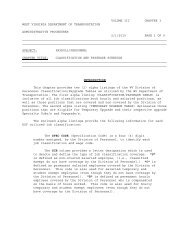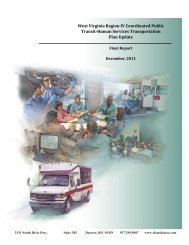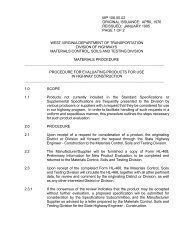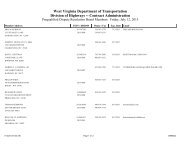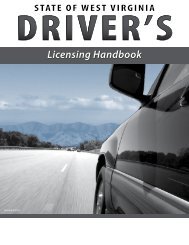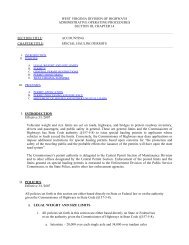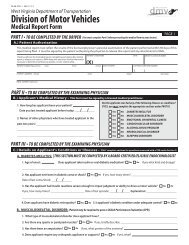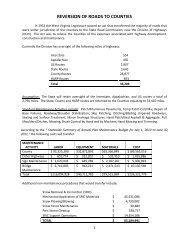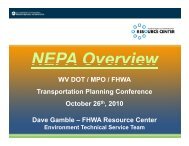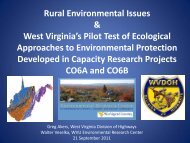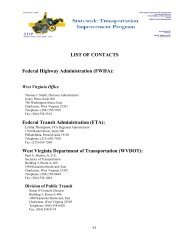Download - West Virginia Department of Transportation
Download - West Virginia Department of Transportation
Download - West Virginia Department of Transportation
Create successful ePaper yourself
Turn your PDF publications into a flip-book with our unique Google optimized e-Paper software.
Dick Henderson Memorial Bridge<br />
Replacement<br />
Finding <strong>of</strong> No Significant Impact<br />
September 6, 2011<br />
Cities <strong>of</strong> Nitro and St. Albans, Kanawha County, <strong>West</strong> <strong>Virginia</strong><br />
State Project No. S220P250.05 00<br />
Federal Project No. BR0025(102)E<br />
Submitted Pursuant to 42 USC 4332(2)(C)<br />
U.S. <strong>Department</strong> <strong>of</strong> <strong>Transportation</strong>, Federal Highway Administration<br />
and<br />
<strong>West</strong> <strong>Virginia</strong> <strong>Department</strong> <strong>of</strong> <strong>Transportation</strong>, Division <strong>of</strong> Highways
Dick Henderson Memorial Bridge Replacement FONSI<br />
ii
Dick Henderson Memorial Bridge Replacement FONSI<br />
Contents<br />
1.0 Project Summary .............................................................................................. 1<br />
Project Purpose and Background................................................................................................................................. 1<br />
Summary <strong>of</strong> Selected Alternative 3 ............................................................................................................................. 2<br />
2.0 Final Section 106 Coordination ........................................................................ 2<br />
3.0 Final Section 4(f) Finding ................................................................................ 3<br />
4.0 Summary <strong>of</strong> Mitigation and Responsibilities ................................................... 3<br />
5.0 Public Comment Period .................................................................................... 5<br />
Support from Regional and City Officials .................................................................................................................. 5<br />
Distribution <strong>of</strong> the Environmental Assessment ..................................................................................................... 5<br />
Informational Public Workshops ................................................................................................................................. 6<br />
Comments on the Environmental Assessment ....................................................................................................... 6<br />
6.0 Additional Information ................................................................................... 15<br />
Kanawha River in the Area <strong>of</strong> the Project ............................................................................................................... 15<br />
River Commerce ................................................................................................................................................................ 15<br />
Construction Sequence ................................................................................................................................................... 17<br />
Impacts .................................................................................................................................................................................. 18<br />
Exhibit 1 – Project Location<br />
Exhibit 2 – Project Area<br />
Exhibit 3 – Selected Alternative<br />
Appendix A ‐ Section 106 Coordination Since Release <strong>of</strong> the EA<br />
Appendix B ‐ Letters <strong>of</strong> Support from Officials Received Since Release <strong>of</strong> the EA<br />
Appendix C – Comments on the EA from Resource Agencies<br />
Appendix D – Example <strong>of</strong> a Notice to Navigation in Vicinity <strong>of</strong> Project<br />
iii
Dick Henderson Memorial Bridge Replacement FONSI<br />
iv
1.0 Project Summary<br />
The <strong>West</strong> <strong>Virginia</strong> <strong>Department</strong> <strong>of</strong> <strong>Transportation</strong>, Division <strong>of</strong> Highways (WVDOH), in cooperation<br />
with the Federal Highway Administration (FHWA), has proposed to rehabilitate or replace the<br />
superstructure <strong>of</strong> the Richard J. “Dick” Henderson Memorial Bridge, also known as the St. Albans‐<br />
Nitro Bridge or Dick Henderson Bridge, in Kanawha County, <strong>West</strong> <strong>Virginia</strong> (Exhibits 1 and 2).<br />
Rehabilitation or replacement <strong>of</strong> the deteriorating superstructure will allow a weight restriction to<br />
be removed and provide a structure that better meets current design standards. As detailed in the<br />
Environmental Assessment (EA), dated July 8, 2011, careful consideration <strong>of</strong> potential<br />
environmental impacts led to selection <strong>of</strong> an alternative that avoids, minimizes and mitigates for<br />
environmental impacts, all <strong>of</strong> which will fall below a level <strong>of</strong> significance.<br />
Project Purpose and Background<br />
The Dick Henderson Bridge was constructed in 1934 and is eligible for listing on the National<br />
Register <strong>of</strong> Historic Places (NRHP). Deterioration <strong>of</strong> the historic structure has warranted placement<br />
<strong>of</strong> a 12‐ton weight limit for vehicles using the bridge, and the current narrow lane width (10 feet) as<br />
well as other bridge elements (e.g., lack <strong>of</strong> shoulders and narrow bridge railing) are not suitable for<br />
modern vehicles. Without the project, the bridge will be closed at some point in the future for<br />
safety considerations, thus severing an important connection between the cities <strong>of</strong> Nitro and St.<br />
Albans across the Kanawha River. For many St. Albans residents, the bridge provides the quickest<br />
access to the closest interstate (I‐64), and the cities’ fire departments have a mutual aid agreement<br />
in place to assist one another, which <strong>of</strong>ten requires using the bridge.<br />
The purpose <strong>of</strong> the project is to rehabilitate or replace the existing Dick Henderson Bridge (i.e., its<br />
superstructure) using the existing river piers so that the rehabilitation or replacement meets<br />
current design standards to effectively serve the transportation needs <strong>of</strong> first responders (e.g., fire<br />
trucks, ambulances, and hazardous materials response vehicles), through travelers, and the<br />
residential, commercial, and business communities <strong>of</strong> the cities <strong>of</strong> St. Albans and Nitro, <strong>West</strong><br />
<strong>Virginia</strong>. Several alternatives were analyzed, as detailed in the EA. The Selected Alternative<br />
(Alternative 3) meets all aspects <strong>of</strong> the project’s purpose and need. The Selected Alternative is<br />
shown in Exhibit 3 and summarized in the following section.<br />
The WVDOH, local planning organization, and cities <strong>of</strong> Nitro and St. Albans have recognized that the<br />
Dick Henderson Bridge has reached the end <strong>of</strong> its functional life and is in need <strong>of</strong> rehabilitation<br />
and/or replacement. While the region has traffic problems other than those related directly to this<br />
bridge crossing, the purpose <strong>of</strong> this project relates to avoiding closure <strong>of</strong> the only bridge currently<br />
available between the two cities. In 2007, WVDOH began an engineering and environmental study<br />
focused on rehabilitating or replacing the bridge’s superstructure as quickly and cost‐effectively as<br />
possible. Testing <strong>of</strong> the bridge’s piers confirmed that they could be used in making the bridge<br />
strong enough to remove the vehicle weight restriction. Following completion <strong>of</strong> the proposed<br />
bridge replacement, the WVDOH will continue to address transportation needs in the region<br />
through pursuing and supporting other long‐term and short‐term strategies. Short‐term solutions<br />
that can alleviate some congestion might include implementation <strong>of</strong> intelligent transportation<br />
systems (ITS) strategies, such as upgrading traffic signals and adjusting signal timing.
Dick Henderson Memorial Bridge Replacement FONSI<br />
Summary <strong>of</strong> Selected Alternative 3<br />
The alternative selected for this project is the same alternative that was presented in the EA as the<br />
Preferred Alternative 3. Selected Alternative 3 includes reinforcing the existing bridge piers (the<br />
supports located in the river) and replacing the existing bridge superstructure (the portion <strong>of</strong> the<br />
bridge that carries traffic over the piers) with a plate girder superstructure. The Selected<br />
Alternative 3 will remove the existing approaches, including the land‐based bridge supports. The<br />
superstructure and land‐based supports will be replaced with two mechanically stabilized earth<br />
(MSE) retaining walls and two river bank abutments. Minimal additional right‐<strong>of</strong>‐way on the land<br />
(approximately 0.4 acre) will be required, mostly on the downstream side <strong>of</strong> both bridge<br />
approaches. The proposed construction will eliminate the weight restriction on the bridge and will<br />
provide a structure that meets current design standards, improving safety and ease <strong>of</strong> travel for the<br />
project area.<br />
Impacts associated with Selected Alternative 3 include no relocations <strong>of</strong> residences or businesses;<br />
improved emergency services; approximately 0.4 acre right‐<strong>of</strong>‐way on land; temporary traffic<br />
detours during construction; temporary economic impact to travelers and local businesses from the<br />
detour necessitated by construction; improved bicycle, pedestrian and wheelchair access; one<br />
crossing <strong>of</strong> waters <strong>of</strong> the U.S. (the Kanawha River); no impacts to Federally listed threatened or<br />
endangered species; no air quality or long‐term noise impacts; temporary noise and aesthetic<br />
impacts from construction; and impacts to two archaeological sites and one historic bridge that are<br />
eligible for listing on the NRHP. Additionally, during the limited intrusive activities, such as<br />
installation <strong>of</strong> new bridge supports, there is a moderate potential for encountering material from<br />
potential hazardous waste sites (e.g., oil) adjacent to the project area.<br />
2.0 Final Section 106 Coordination<br />
As documented in the EA, one historic structure (the bridge itself) and two archaeological sites that<br />
are eligible for listing on the NRHP will be adversely affected by the project. Since publication <strong>of</strong> the<br />
EA, coordination regarding mitigation for these impacts has been finalized in accordance with<br />
Section 106 <strong>of</strong> the National Historic Preservation Act. The Memorandum <strong>of</strong> Agreement (MOA), a<br />
draft <strong>of</strong> which was included with the EA, has been finalized and is included with Appendix A <strong>of</strong> this<br />
Finding <strong>of</strong> No Significant Impact (FONSI) document. Mitigation commitments contained in the MOA<br />
are summarized in Table 1.<br />
The project has included coordination with the Kanawha Valley Historical and Preservation Society,<br />
the St. Albans Historical Society, and the cities <strong>of</strong> Nitro and St. Albans, in addition to the State<br />
Historic Preservation Officer (SHPO). All <strong>of</strong> these entities are consulting parties and have signed<br />
the MOA.<br />
FHWA contacted the Advisory Council on Historic Preservation (ACHP) to inform them about the<br />
project and the adverse effects <strong>of</strong> the project on resources eligible for listing on the NRHP. In a<br />
letter dated July 12, 2011, ACHP declined the <strong>of</strong>fer to participate in the Section 106 consultation<br />
process (Appendix A). However, pursuant to 36 CFR 800.6(b)(1)(iv), the approved MOA and<br />
2
Dick Henderson Memorial Bridge Replacement FONSI<br />
related documentation has been submitted to ACHP to conclude the Section 106 consultation<br />
process.<br />
3.0 Final Section 4(f) Finding<br />
Under Section 4(f) <strong>of</strong> the <strong>Department</strong> <strong>of</strong> <strong>Transportation</strong> Act <strong>of</strong> 1966 (49 USC Section 303 and 23<br />
CFR Part 774), FHWA may not approve the use <strong>of</strong> land from a publicly‐owned public park unless a<br />
determination is made that:<br />
(i) there is no feasible and prudent alternative to the use <strong>of</strong> land from the property; and<br />
(ii) the action includes all possible planning to minimize harm to the property resulting from such<br />
use.<br />
In 1983. FHWA issued a Programmatic Evaluation and Approval that could be applied to projects<br />
that were proposing to use an historic bridge if certain conditions applied. A programmatic<br />
evaluation supplants the need for an individual evaluation for a project to satisfy Section 4(f)<br />
requirements. The complete “Programmatic Section 4(f) Evaluation and Approval for FHWA<br />
Projects that Necessitate the Use <strong>of</strong> Historic Bridges” can be found at the FHWA website<br />
(http://www.environment.fhwa.dot.gov/4f/4fnationwideevals.asp). As documented in the EA,<br />
FHWA made the determination that the project meets the conditions required for this<br />
Programmatic Evaluation and Approval. No comments were received on this determination. No<br />
further analysis or coordination is required for meeting Section 4(f) requirements.<br />
4.0 Summary <strong>of</strong> Mitigation and Responsibilities<br />
Table 1 reviews the mitigation commitments planned in association with the Dick Henderson<br />
Memorial Bridge Replacement project to reduce impacts.<br />
Table 1: Summary <strong>of</strong> Mitigation<br />
Resource/Issue<br />
Aquatic Habitat<br />
Hazardous Materials<br />
Residences<br />
Mitigation Measure<br />
Construction will include Best Management Practices to control<br />
sedimentation and erosion. Removal <strong>of</strong> vegetation from the riparian zone<br />
will be kept to the minimum and all disturbed areas will be reseeded with<br />
native vegetation.<br />
Should hazardous materials be encountered prior to or during the<br />
construction phase <strong>of</strong> the proposed action, any identified waste will be<br />
managed according to applicable federal and state laws, ordinances, and<br />
regulations. Proper worker and environmental safety protocols will be<br />
followed .<br />
Outside <strong>of</strong> existing transportation right‐<strong>of</strong>‐way, the project requires<br />
approximately 0.40 acre <strong>of</strong> land spread over 15 adjacent parcels. However,<br />
no relocations are required. Acquisition will be conducted in accordance<br />
with the Uniform Relocation Assistance and Real Property Acquisition<br />
Policies Act <strong>of</strong> 1970 as amended.<br />
3
Dick Henderson Memorial Bridge Replacement FONSI<br />
Resource/Issue<br />
Construction Impacts<br />
‐ Traffic<br />
Construction Impacts<br />
‐ Noise<br />
Historic Properties and<br />
Archaeological Sites<br />
‐ General<br />
Historic Resource<br />
‐ Dick Henderson<br />
Memorial Bridge<br />
Mitigation Measure<br />
A maintenance <strong>of</strong> traffic plan will be developed and implemented during<br />
construction to assure both motorist and construction worker safety. This<br />
plan will be developed using guidelines <strong>of</strong> FHWA, the American Association<br />
<strong>of</strong> State Highway and <strong>Transportation</strong> Officials, and WVDOH.<br />
Control <strong>of</strong> the temporary construction impacts will be governed by the<br />
Standard Specifications for Road and Bridge Construction.<br />
Construction for this project will be timed such that bridge closure will<br />
begin after January 1, 2013, with the goal <strong>of</strong> re‐opening the bridge to traffic<br />
in early November <strong>of</strong> that same year.<br />
Control <strong>of</strong> construction noise will be governed by WVDOT’s Standard<br />
Specifications for Road and Bridge Construction and additional abatement<br />
measures developed specifically for the action. The following noise<br />
abatement measures have been planned for this project:<br />
• Manufacturer’s muffling devices are required to be installed and<br />
functional on all equipment.<br />
• Equipment must meet the minimum, applicable USEPA Standards.<br />
• The project has incorporated micropiles or drilled shafts (caissons) for<br />
support <strong>of</strong> the abutments and piers in order to reduce noise and vibration.<br />
• Additional mitigation measures for noise will be implemented according<br />
to a Special Provision for the contract plan, to be finalized prior to<br />
construction.<br />
If any unanticipated discoveries are encountered during project<br />
implementation, work will be suspended in the area <strong>of</strong> the discovery until<br />
the WVDOH has developed and implemented an appropriate treatment plan<br />
in consultation with the WVSHPO pursuant to 36 CFR 800.13(b).<br />
• The history and present historic setting <strong>of</strong> the Dick Henderson Memorial<br />
Bridge will be documented in accordance with stipulations in the MOA<br />
(Appendix A).<br />
• WVDOH will provide the St. Albans Historical Society and the Kanawha<br />
County Public Library branches in St. Albans and Nitro with historic<br />
documentation packages.<br />
• WVDOH will sponsor a historical essay contest for graduating high school<br />
seniors from the two cities. A $5,000 scholarship will be awarded to each <strong>of</strong><br />
the two high schools.<br />
• WVDOH will provide $20,000 to St. Albans and $20,000 to Nitro for<br />
preservation activities and projects within those two cities, to be performed<br />
in accordance with the MOA (Appendix A).<br />
• The bridge will contain historic style lighting and architectural treatments<br />
matching the St. Albans Historic District.<br />
4
Dick Henderson Memorial Bridge Replacement FONSI<br />
Resource/Issue<br />
Archaeological<br />
Resources<br />
‐ Two sites eligible<br />
for the NRHP<br />
Visual Impact<br />
Mitigation Measure<br />
• WVDOH will perform archaeological monitoring <strong>of</strong> the project area during<br />
construction, and will submit a technical report for review by SHPO once<br />
the project is complete.<br />
• WVDOH will provide a monument or educational display marker<br />
discussing previous indigenous lifeways in the Kanawha River Valley to be<br />
placed at a publically accessible location nearby.<br />
• WVDOH will provide $50,000 to be used for <strong>of</strong>f‐site mitigation <strong>of</strong><br />
archaeological resources, in accordance with the signed MOA.<br />
In general, the bridge is being designed with consideration for the<br />
community context. Specifically, the bridge will contain historic style lighting<br />
and architectural treatments matching the St. Albans Historic District.<br />
5.0 Public Comment Period<br />
Development <strong>of</strong> the EA involved coordination with local, state, and Federal agencies, and the public.<br />
A summary <strong>of</strong> coordination since publication <strong>of</strong> the EA and responses to substantive comments on<br />
the EA are presented in the following sections.<br />
Support from Regional and City Officials<br />
The EA includes a letter expressing support for the Dick Henderson Bridge Replacement project<br />
from the Boone, Clay, Kanawha, and Putnam County Regional Intergovernmental Council, the area’s<br />
Metropolitan Planning Organization (MPO). Since publication <strong>of</strong> the EA, the cities <strong>of</strong> Nitro and St.<br />
Albans have also sent WVDOH letters <strong>of</strong> support. These letters are included with Appendix B.<br />
Distribution <strong>of</strong> the Environmental Assessment<br />
A digital version <strong>of</strong> the EA was made available through a link on the WVDOH website. Bound copies<br />
<strong>of</strong> the EA were also made available for review at local libraries and at the July 2011 public<br />
informational workshops. Bound copies <strong>of</strong> the EA were delivered or sent to the following agencies<br />
or individuals:<br />
U.S. Army Corps <strong>of</strong> Engineers, Huntington District<br />
U.S. Coast Guard, 8 th Coast Guard District, Bridge Administrator<br />
U.S. <strong>Department</strong> <strong>of</strong> the Interior, Fish and Wildlife Service, <strong>West</strong> <strong>Virginia</strong> Field Office<br />
U.S. Environmental Protection Agency (USEPA), Region 3<br />
WV <strong>Department</strong> <strong>of</strong> Environmental Protection, Cabinet Secretary<br />
WV <strong>Department</strong> <strong>of</strong> Environmental Protection, Office <strong>of</strong> Air Quality<br />
WV <strong>Department</strong> <strong>of</strong> Environmental Protection, Water Resources Section<br />
WV Division <strong>of</strong> Culture and History, State Historic Preservation Officer<br />
WV Division <strong>of</strong> Natural Resources<br />
Boone, Clay, Kanawha, and Putnam County Regional Intergovernmental Council<br />
City <strong>of</strong> Nitro<br />
City <strong>of</strong> St. Albans<br />
Kanawha Valley Historical & Preservation Society<br />
5
Dick Henderson Memorial Bridge Replacement FONSI<br />
<br />
<br />
Preservation Alliance <strong>of</strong> <strong>West</strong> <strong>Virginia</strong><br />
St. Albans Historical Society<br />
Informational Public Workshops<br />
Public informational workshops were held on July 25 th and July 26 th , 2011 at the St. Albans High<br />
School and Nitro High School, respectively. Workshops included a presentation by WVDOH, a<br />
display <strong>of</strong> maps and informational boards, and a hand‐out. Personnel from WVDOH and FHWA<br />
were available to answer questions, and attendees were encouraged to submit comments. The St.<br />
Albans and Nitro meetings had approximately 35 and 55 attendees, respectively.<br />
Comments on the Environmental Assessment<br />
The comment period for the EA ended August 26 th , 2011. Two comment letters were received from<br />
regulatory agencies, including the <strong>West</strong> <strong>Virginia</strong> <strong>Department</strong> <strong>of</strong> Environmental Protection, Division<br />
<strong>of</strong> Air Quality and the U.S. Coast Guard. Copies <strong>of</strong> these comment letters are included in Appendix C<br />
and responses to comments are provided in Table 2.<br />
A total <strong>of</strong> 12 comment sheets and letters were received from members <strong>of</strong> the public. Substantive<br />
comments from these submissions and responses to them are provided in Table 2.<br />
6
Table 2: Responses to Comments on the Environmental Assessment<br />
Comment<br />
ID<br />
AGENCY COMMENTS<br />
Agency Comment Response<br />
7<br />
1<br />
2<br />
3<br />
U.S. <strong>Department</strong> <strong>of</strong><br />
Homeland Security,<br />
U.S. Coast Guard<br />
U.S. <strong>Department</strong> <strong>of</strong><br />
Homeland Security,<br />
U.S. Coast Guard<br />
U.S. <strong>Department</strong> <strong>of</strong><br />
Homeland Security,<br />
U.S. Coast Guard<br />
“a. Expand on the description <strong>of</strong> the<br />
Kanawha River in 3.4, Surface Waters section, to<br />
include a description <strong>of</strong> the river commerce in<br />
terms <strong>of</strong> numbers, sizes, and types <strong>of</strong> vessels<br />
used to move various specified commodities and<br />
the marine facilities which support the efficient<br />
movement <strong>of</strong> same.”<br />
“b. Provide an analysis <strong>of</strong> the current vessel<br />
traffic, a forecast <strong>of</strong> future traffic and describe<br />
the impact the bridge may have on future<br />
growth.”<br />
“c. Describe construction and demolition<br />
activities which will impact navigation and<br />
include the Coast Guard requirement that<br />
falsework bents must allow at least 300 feet <strong>of</strong><br />
clearance in the channel.”<br />
See Section 6.0 <strong>of</strong> this FONSI document for<br />
additional information on the Kanawha River.<br />
See Section 6.0 <strong>of</strong> this FONSI document for<br />
additional information on the Kanawha River.<br />
Because <strong>of</strong> the complex nature <strong>of</strong> demand for the<br />
commodities transported along the river (e.g., the<br />
demand for coal depends in part on changing<br />
energy demands and fluctuating prices <strong>of</strong> oil,<br />
which in turn can be affected by weather, political<br />
activities, etc.), the discussion does not include a<br />
forecast <strong>of</strong> future traffic. However, Section 6.0<br />
includes a summary <strong>of</strong> the most recent available<br />
annual vessel traffic provided by the U.S. Army<br />
Corps <strong>of</strong> Engineers (USACE), and a discussion <strong>of</strong><br />
potential impacts <strong>of</strong> the project on vessel traffic.<br />
See Section 6.0 <strong>of</strong> this FONSI document for detail<br />
on construction plans and potential impacts to<br />
navigation.<br />
A minimum clearance <strong>of</strong> 300 feet will be<br />
maintained in the channel throughout<br />
construction.<br />
Dick Henderson Memorial Bridge Replacement FONSI
Comment<br />
ID<br />
Agency Comment Response<br />
4<br />
U.S. <strong>Department</strong> <strong>of</strong><br />
Homeland Security,<br />
U.S. Coast Guard<br />
“d. Include a statement that the Coast Guard<br />
requires the project to comply with Section 401<br />
<strong>of</strong> the Clean Water Act and that a Water Quality<br />
Certificate is required before a bridge permit is<br />
issued.”<br />
Prior to construction, WVDOH will secure a Clean<br />
Water Act Section 401 Water Quality Certification.<br />
It is understood that this certification is also<br />
required prior to acquiring a bridge permit from<br />
the U.S. Coast Guard.<br />
8<br />
5<br />
6<br />
U.S. <strong>Department</strong> <strong>of</strong><br />
Homeland Security,<br />
U.S. Coast Guard<br />
U.S. <strong>Department</strong> <strong>of</strong><br />
Homeland Security,<br />
U.S. Coast Guard<br />
“e. In 3.5, Fish and Wildlife section, include a<br />
comment on the applicability <strong>of</strong> the Migratory<br />
Bird Act <strong>of</strong> 1918 and Executive Order 13186,<br />
dated January 17, 2001 if there is a migratory<br />
bird habitat that exists in the vicinity. If not, so<br />
state.”<br />
“f. The date cited in 1.3, Project background<br />
section, item 2 should be corrected to April 13,<br />
2010.”<br />
The Migratory Bird Treaty Act (MBTA) <strong>of</strong> 1918<br />
protects migratory birds, active nests, eggs,<br />
and/or young. The project will be implemented in<br />
full compliance with all provisions and regulations<br />
outlined in and pursuant to the MBTA (16 USC<br />
703‐711). Coordination with the WVDNR and<br />
USFWS did not reveal concerns for potential<br />
impacts to migratory bird habitat as a result <strong>of</strong><br />
this project. It is unlikely that nests, eggs, or<br />
young <strong>of</strong> migratory birds would be impacted by<br />
the project because demolition is planned to take<br />
place prior to the spring <strong>of</strong> 2013 (nesting season),<br />
and, with all the construction activity, it is unlikely<br />
birds would settle within the project area that<br />
year.<br />
Comment noted.<br />
Dick Henderson Memorial Bridge Replacement FONSI<br />
7<br />
WV <strong>Department</strong> <strong>of</strong><br />
Environmental<br />
Protection, Division<br />
<strong>of</strong> Air Quality<br />
“The ozone discussion alludes to ‘an<br />
accompanying air quality conformity analysis”<br />
but stops short <strong>of</strong> confirming that the project is<br />
included in a conforming TIP and LRTP which<br />
have been approved by FHWA. This should be<br />
added.”<br />
The project is included in a TIP and LRTP for<br />
which FHWA approved a positive conformity<br />
determination.
Comment<br />
ID<br />
Agency Comment Response<br />
9<br />
8<br />
9<br />
10<br />
WV <strong>Department</strong> <strong>of</strong><br />
Environmental<br />
Protection, Division<br />
<strong>of</strong> Air Quality<br />
WV <strong>Department</strong> <strong>of</strong><br />
Environmental<br />
Protection, Division<br />
<strong>of</strong> Air Quality<br />
WV <strong>Department</strong> <strong>of</strong><br />
Environmental<br />
Protection, Division<br />
<strong>of</strong> Air Quality<br />
“The PM 2.5 section should recognize both the<br />
1997 and 2006 NAAQS and authors may consider<br />
briefly reiterating the conformity considerations<br />
because they involve significant differences from<br />
the ozone standard (e.g. annual vs. summer day<br />
emissions for the 1997 NAAQS) as well as<br />
different emission tests (i.e. interim build‐vs.‐<br />
base year compared to budget test). At a<br />
minimum, the authors should confirm that the<br />
appropriate emissions analyses were performed<br />
for both PM 2.5 standards . . .”<br />
“If it is necessary to burn land clearing debris in<br />
order to complete the project, approval by the<br />
WVDEP Secretary or his or her authorized<br />
representative is required to conduct such<br />
burning (see 45CSR6).”<br />
“If the project entails the renovation, remodeling,<br />
or demolition, either partially or totally, <strong>of</strong> a<br />
structure, building, or installation, irrespective <strong>of</strong><br />
the presence or absence <strong>of</strong> asbestos‐containing<br />
materials, and is subject to 45CSR15 (the<br />
asbestos NESHAP at 40CFR61, Subpart M), a<br />
formal Notification <strong>of</strong> Abatement, Demolition, or<br />
Renovation must be completed and timely filed<br />
with the WVDEP Secretary’s authorized<br />
representative and approval received before<br />
commencement <strong>of</strong> the activities addressed in the<br />
Notification.”<br />
It is understood that the designated nonattainment<br />
status is for both the 1997 and 2006<br />
NAAQS. The emissions analyses were performed<br />
for both standards.<br />
It is not anticipated that burning will be<br />
necessary; however, if it is necessary to burn<br />
debris, it would be conducted in accordance with<br />
45CSR6.<br />
Air pollution control measures will be included<br />
with the project in accordance with the WVDOT’s<br />
Standard Specifications for Road and Bridge<br />
Construction, and applicable regulations <strong>of</strong> the<br />
<strong>West</strong> <strong>Virginia</strong> Air Pollution Control Commission.<br />
The Contractor will be required to obtain<br />
approval <strong>of</strong> the “Abatement, Demolition, or<br />
Renovation” prior to the construction activities.<br />
Dick Henderson Memorial Bridge Replacement FONSI
Comment<br />
ID<br />
Agency Comment Response<br />
10<br />
11<br />
Comment<br />
ID<br />
12<br />
13<br />
WV <strong>Department</strong> <strong>of</strong><br />
Environmental<br />
Protection, Division<br />
<strong>of</strong> Air Quality<br />
“If the project involves demolition, and/or<br />
excavation and transportation <strong>of</strong> soil/aggregates<br />
or the handling <strong>of</strong> materials that can cause<br />
problems such as nuisance dust emissions or<br />
entrainment or creation <strong>of</strong> objectionable odors,<br />
adequate air pollution control measures must be<br />
applied to prevent statutory air pollution<br />
problems as addressed by 45CSR4 and<br />
45CSR17.”<br />
Comment<br />
“Extend merge lane (East) Nitro side [turning<br />
onto Rt. 25 from the bridge].”<br />
“Make the original bridge safe, but build a new<br />
bridge at Walnut Street.”<br />
PUBLIC COMMENTS<br />
Air pollution control measures will be included<br />
with the project in accordance with the WVDOT’s<br />
Standard Specifications for Road and Bridge<br />
Construction, and applicable regulations <strong>of</strong> the<br />
<strong>West</strong> <strong>Virginia</strong> Air Pollution Control Commission.<br />
Response<br />
Providing additional merging length at the Center Street/WV Route 25<br />
intersection may improve traffic flow at that location, but it would not<br />
address the purpose and need for this project. However, as addressed in<br />
the EA, Section 1.3 (“Project Background”), following completion <strong>of</strong> the<br />
proposed superstructure replacement, the WVDOH will continue to<br />
address transportation needs in the region through pursuing and<br />
supporting other long‐term and short‐term strategies.<br />
As required to satisfy the project purpose, Selected Alternative 3 will<br />
provide a safer bridge. A new bridge would be part <strong>of</strong> a separate project.<br />
The subject <strong>of</strong> an additional bridge is addressed in the EA, Section 1.3<br />
(“Project Background”).<br />
Dick Henderson Memorial Bridge Replacement FONSI
Comment<br />
ID<br />
Comment<br />
Response<br />
11<br />
14<br />
“In order to help the businesses at the East end <strong>of</strong><br />
Nitro, businesses, the Interstate exit signs should<br />
refer to Nitro, the Institute interstate exit sign<br />
should include Nitro. In fact, the signage should<br />
include one that says ‘Nitro – next 3 exits.’”<br />
Based upon criteria established by the federal Manual on Uniform<br />
Traffic Control Devices, WVDOH has established control destinations for<br />
every freeway, expressway, and US or state primary route in <strong>West</strong><br />
<strong>Virginia</strong>. The primary purpose <strong>of</strong> control destination cities and towns<br />
are to provide navigational guidance to motorists, particularly to the<br />
non‐local motorist. These control destinations are selected based upon<br />
proximity to the highway and also upon population and traffic<br />
generation. Signage for the cities and towns used as control destinations<br />
are not specifically intended as advertising or marketing for a particular<br />
town, but rather as a notice for non‐local travelers that the highway will<br />
take them in the general direction <strong>of</strong> that place. Typically, for control<br />
destinations that are cities, signing is associated with the interchange<br />
that will route the motorists most closely to the center <strong>of</strong> the city and its<br />
governmental buildings.<br />
Nitro is the control destination on I‐64 at Exit 45, and Institute is the<br />
control destination at Exit 50. Both <strong>of</strong> these towns are located very near<br />
the interstate system, which provides navigation and identification <strong>of</strong><br />
each interchange. Because <strong>of</strong> the many closely spaced communities in<br />
the Kanawha Valley, it is the primary intent <strong>of</strong> WVDOH to provide<br />
signing information that designates one major access point to each City.<br />
This not only conforms with signing guidelines, but also better serves<br />
the needs <strong>of</strong> the non‐local drivers.<br />
A change in this policy to oblige freeway destination signing for reasons<br />
other than pure navigation would sacrifice the information we provide<br />
to motorists.<br />
Dick Henderson Memorial Bridge Replacement FONSI
Comment<br />
ID<br />
Comment<br />
Response<br />
15<br />
“I would like to see larger signage on each side <strong>of</strong><br />
the bridge so that boats/ships/sternwheelers, etc.<br />
would be able to see it clearly.<br />
“Also, the lighting should be in keeping with the<br />
“old style” lighting from the city <strong>of</strong> St. Albans –<br />
lighting, for example, like that lining Kanawha<br />
Blvd. in Charleston.”<br />
The bridge will contain historic‐style lighting and architectural<br />
treatments matching the St. Albans Historic District. The design <strong>of</strong> the<br />
bridge includes the addition <strong>of</strong> signs embedded within the railings that<br />
read, “Nitro,” “Twin Cities,” and “Saint Albans.” The lettering will be<br />
visible both from atop the bridge and from boats/ships near the bridge,<br />
but also will be sized in accordance with the scale <strong>of</strong> the bridge and<br />
railings themselves.<br />
12<br />
16<br />
17<br />
18<br />
“Must have a traffic light at Main Ave and Center<br />
St where bridge where bridge access ends. This is<br />
a very dangerous section before the new bridge<br />
and will be more “danger zone” when new bridge<br />
opens.”<br />
“It would be extremely helpful if the existing<br />
connecting sidewalk between Sattes Circle and the<br />
bridge sidewalk between Sattes Circle and the<br />
bridge sidewalk could be retained. It might need<br />
to be re‐located +upgraded, but we hope it will<br />
still be available to pedestrians + cyclists. This<br />
gives access to the KRT transportation system.”<br />
“Make sure river traffic can continue to have<br />
access to our docks.”<br />
This intersection is located approximately 400 feet from the existing WV<br />
25 signal and approximately 140 feet from the existing RR crossing. The<br />
minimum traffic signal spacing in urban areas is typically 600 feet, and<br />
ideally more (¼ mile [1,320 feet] to ½ mile [2,640 feet]). Installing a<br />
signal at this location would significantly change the operations in the<br />
area. Signalizing Main Street would require coordination between the<br />
WV 25 signal and the RR crossing.<br />
This access will be maintained and will be improved to provide better<br />
accommodation <strong>of</strong> wheelchairs. From the existing connection with<br />
Sattes Circle, there will be a 4‐foot wide concrete sidewalk on the<br />
downstream side <strong>of</strong> the bridge that will connect to the sidewalk atop the<br />
bridge around the new retaining wall.<br />
The docks along the Nitro bank <strong>of</strong> the river are outside the project right<strong>of</strong>‐way.<br />
No permanent impacts are proposed to these docks.<br />
However, temporary interruptions <strong>of</strong> access may occur during<br />
construction. Access to waters near the bridge by vessels in the river<br />
will be stopped during construction activities that pose a threat to river<br />
traffic safety. See Section 6.0 <strong>of</strong> this FONSI document for more<br />
information on construction schedule and impacts to navigation.<br />
Dick Henderson Memorial Bridge Replacement FONSI
Comment<br />
ID<br />
Comment<br />
Response<br />
13<br />
19<br />
20<br />
“Pls. plan ahead to make sure I‐64 repairs/paving<br />
are all done before we are forced to drive it every<br />
day beginning in January 2013.”<br />
“Try and keep noise, dirt low[,] + water traffic<br />
moving.”<br />
To avoid cumulative economic impacts, as well as to allow detour routes<br />
for avoiding construction zones during each project, WVDOH will ensure<br />
the Dick Henderson Bridge closure does not coincide with major work<br />
on I‐64 crossing the Kanawha River. However, if emergency repairs are<br />
needed anywhere along the detour routes, they may have to be<br />
addressed simultaneously as a safety measure. With respect to the<br />
condition <strong>of</strong> I‐64 pavement, minor repairs may be made prior to the<br />
detour being enacted.<br />
A special provision for construction noise control and community<br />
coordination has been integrated to the construction plans for this<br />
project.<br />
See Table 1, “Construction Impacts – Noise” for detail on mitigation for<br />
construction noise.<br />
No long‐term impacts to air quality are anticipated from the project.<br />
Temporary increases in air pollution may occur from construction<br />
activities and will be minimized through the use <strong>of</strong> best management<br />
practices and in accordance with WVDOT’s Standard Specifications for<br />
Road and Bridge Construction and applicable regulations <strong>of</strong> the <strong>West</strong><br />
<strong>Virginia</strong> Air Pollution Control Commission.<br />
Water traffic will be allowed to move normally for much <strong>of</strong> the<br />
construction process; however, traffic will be kept from passing under<br />
the bridge during bridge demolition and other construction activities<br />
that pose a threat to river traffic safety. See Section 6.0 <strong>of</strong> this FONSI<br />
document for more information on river traffic.<br />
Dick Henderson Memorial Bridge Replacement FONSI
Comment<br />
ID<br />
Comment<br />
Response<br />
14<br />
21<br />
22<br />
23<br />
24<br />
“Please consider adding a second pedestrian<br />
walkway to the upstream side <strong>of</strong> the bridge. Also,<br />
please consider adding cross walks to the Rt. 60<br />
intersection. . . . I request these items be added<br />
because a pedestrian walking from downtown St.<br />
Albans to Fenton Circle in Nitro would walk the<br />
CSX underpass then cross Third Street (busy) then<br />
Rt. 60 (dangerous) to reach the bridge walkway +<br />
then have to cross the street again on the Nitro<br />
Side.”<br />
“Finally, please consider adding electrical conduit<br />
to the superstructure (eastern side) for future<br />
lighting.”<br />
“Please keep the <strong>of</strong>ficial name <strong>of</strong> the bridge St.<br />
Albans‐Nitro (on brass plaque). . . .Then on a<br />
smaller green sign it could be named for someone.<br />
”Would be nice if existing plaques could be<br />
incorporated into new bridge. There used to be a<br />
larger plaque on St. Albans side that as bolted<br />
onto metal railing, whatever happened to that”<br />
“The 2‐lane portion going to St. Albans should be<br />
lengthened some (toward Nitro) traffic coming to<br />
Nitro very seldom backs up onto bridge.”<br />
For a second pedestrian walkway, an additional five (5) feet <strong>of</strong> bridge<br />
width would need to be added to the bridge and the approaches to the<br />
bridge. This would add significant cost as well as impact to lands<br />
adjacent to the approaches on land.<br />
As addressed in the EA, Section 1.3 (“Project Background”), following<br />
completion <strong>of</strong> the proposed superstructure replacement, the WVDOH<br />
will continue to address transportation needs in the region through<br />
pursuing and supporting other long‐term and short‐term strategies.<br />
Present construction plans include 2‐inch diameter rigid conduit in both<br />
the upstream and downstream railing for bridge roadway lighting. Also,<br />
plans include a 1.5‐inch diameter rigid conduit in the downstream rail<br />
for the navigation lights.<br />
The existing plaques have been removed to avoid theft, and will be<br />
incorporated to the historic mitigation activities (see Table1).<br />
The projected traffic volumes were analyzed and the location <strong>of</strong> the left<br />
turn lane transition was selected to provide optimum traffic movement<br />
on both the St. Albans and Nitro sides.<br />
Dick Henderson Memorial Bridge Replacement FONSI<br />
25 “Please paint a neutral color.”<br />
As with other design elements for the bridge, the color will blend with<br />
historic elements <strong>of</strong> nearby neighborhoods.<br />
26<br />
“For traffic going to St. Albans maybe there would<br />
be room for a turn lane going east on route 60,<br />
one lane going straight, and one going west on<br />
route 60.”<br />
The available space for traffic lanes does not allow for a third<br />
southbound lane without substantial additional right‐<strong>of</strong>‐way impacts.<br />
See also the response to Comment 21.
Dick Henderson Memorial Bridge Replacement FONSI<br />
6.0 Additional Information<br />
Kanawha River in the Area <strong>of</strong> the Project<br />
With a navigable length <strong>of</strong> 91 miles entirely within <strong>West</strong> <strong>Virginia</strong>, the Kanawha River is a major<br />
tributary to the Ohio River and plays an important role in the <strong>West</strong> <strong>Virginia</strong> economy. Navigational<br />
operations on the Kanawha River are controlled by the Huntington District <strong>of</strong> the U.S. Army Corps<br />
<strong>of</strong> Engineers (USACE). The Kanawha River has three navigation locks. To either side <strong>of</strong> the Dick<br />
Henderson Bridge, the Winfield locks and dam system is approximately 15 river miles downstream,<br />
and the Marmet locks and dam system is approximately 22 river miles upstream.<br />
The Winfield locks and dam system lies in Red House, WV, just west <strong>of</strong> Winfield, 31.1 nautical miles<br />
upstream <strong>of</strong> the river mouth. Although built in 1937, with two locks <strong>of</strong> 360‐foot width and 56‐foot<br />
length, major renovations completed in 1998 added a much longer lock <strong>of</strong> 110 feet by 800 feet.<br />
Some hydroelectric power generation takes place at this facility. Between 2000 and the end <strong>of</strong><br />
2010, an average <strong>of</strong> 3,247 vessels used the Winfield locks and dam system. As a representative<br />
example <strong>of</strong> the types <strong>of</strong> vessels using the system, in 2010, the total <strong>of</strong> 3,032 vessels was comprised<br />
<strong>of</strong> 2,550 tow or tugboats, 29 Federal government vessels, 46 lightboats, and 402 recreation boats<br />
(U.S. Army Corps <strong>of</strong> Engineers Waterborne Commerce Statistics, data provided in August 2011).<br />
More detail on commercial activity associated with these vessels is provided in the following<br />
section.<br />
The Marmet locks and dam system lies in Marmet, WV, 67.8 nautical miles upstream <strong>of</strong> the river<br />
mouth. Although built in 1933, with two locks <strong>of</strong> 360‐foot width and 56‐foot length, major<br />
renovations completed in 2008 added a much longer lock <strong>of</strong> 110 feet by 800 feet. No hydroelectric<br />
power generation takes place at this facility. Between 2000 and the end <strong>of</strong> 2010, an average <strong>of</strong><br />
4,685 vessels used the Marmet locks and dam system. As a representative example <strong>of</strong> the types <strong>of</strong><br />
vessels using the system, in 2010, the total <strong>of</strong> 3,665 vessels was comprised <strong>of</strong> 2,663 tow or<br />
tugboats, 11 Federal government vessels, 131 lightboats, and 860 recreation boats (U.S. Army<br />
Corps <strong>of</strong> Engineers Waterborne Commerce Statistics, data provided August 30, 2011). More detail<br />
on commercial activity associated with these vessels is provided in the following section.<br />
The portion <strong>of</strong> the Kanawha River between the two dams is referred to as the Winfield pool. The<br />
normal pool elevation above the Winfield dam is 566 feet above mean sea level. The length <strong>of</strong> the<br />
pool is 36.7 nautical miles, and the area is 3,100 acres. The lift from below the Winfield system is<br />
28 feet, and the lift to the pool upstream <strong>of</strong> the Marmet system is 24 feet.<br />
River Commerce<br />
In 2008, 20.1 million tons <strong>of</strong> commodities were moved along the Kanawha River. Of the<br />
commodities moved on the Kanawha River, coal comprised 76 percent (15.3 million tons). <strong>West</strong><br />
<strong>Virginia</strong> is the second leading coal‐producing state in the country, and barge transportation is a<br />
major means <strong>of</strong> getting coal to market efficiently. Other commodities frequently transported via<br />
the Kanawha River include petroleum, chemicals, and aggregates. (USACE, Navigation Data<br />
Information System website for <strong>West</strong> <strong>Virginia</strong>, retrieved August 25, 2011).<br />
15
Dick Henderson Memorial Bridge Replacement FONSI<br />
As stated in the USACE’s Great Lakes and Ohio River Navigation Systems Commerce Report, 2008,<br />
“Lock capacities correlate with lock sizes and many <strong>of</strong> the smaller locks have become congested due<br />
to increased traffic. This congestion produces delays, adds to industry’s costs, and reduces<br />
transportation savings. Kanawha River congestion was relieved with the 1997 opening <strong>of</strong> a new<br />
larger Winfield Lock and in 2008 with the opening <strong>of</strong> the new, larger Marmet lock. The<br />
replacement locks <strong>of</strong> Winfield and Marmet have reduced average tow delays by 75 percent, from<br />
over two hours to less than 30 minutes.”<br />
Although delays have been reduced, data from before and after renovations at the Marmet locks<br />
and dam system (completed in 2008) do not reveal that the total number <strong>of</strong> vessels was affected by<br />
the decrease in delay (data was not available for the Winfield system from prior to 1997<br />
renovations). Prior to 2007 and back to 2000, total number <strong>of</strong> vessels using the Marmet locks and<br />
dam had not fallen below 4,500, while in 2009 and 2010, a total <strong>of</strong> 3,182 and 3,665 vessels used the<br />
system, respectively. (U.S. Army Corps <strong>of</strong> Engineers Waterborne Commerce Statistics, data<br />
provided August 30, 2011).<br />
Within the Winfield Pool, there are approximately 12 freight terminal docks downstream and 16<br />
freight terminal docks upstream <strong>of</strong> the Dick Henderson Bridge. Major destinations <strong>of</strong> vessels in the<br />
Winfield pool include several marinas, the John Amos Plant <strong>of</strong> the American Electric Power<br />
Company, Amherst Industries, Olin Chemical, Union Carbide, Dow, Bayer Cropscience, Chevron,<br />
Exxon, and several concrete and other building supply company docks. (Kanawha River charts,<br />
Nos. 9‐20, revised 2004)<br />
2008 and 2009 commodities data for both the Winfield and Marmet lock and dam systems are<br />
provided in Table 3. Project activities and their potential impact on navigation are addressed in the<br />
following sections.<br />
16
Dick Henderson Memorial Bridge Replacement FONSI<br />
Table 3: Summary <strong>of</strong> 2009 Commodity Movement Downstream and Upstream <strong>of</strong> the Project Area<br />
Commodity<br />
Coal<br />
Petroleum<br />
Aggregates<br />
Chemicals<br />
2009 Tonnage and % <strong>of</strong> Total through<br />
Winfield Locks and Dam<br />
12,242,247<br />
(75%)<br />
926,855<br />
(6%)<br />
2,331,411<br />
(14%)<br />
441,251<br />
(3%)<br />
2009 Tonnage and % <strong>of</strong> Total through<br />
Marmet Locks and Dam<br />
12,261,622<br />
(93%)<br />
**<br />
390,484<br />
(3%)<br />
155,438<br />
(1%)<br />
Ores/Minerals ** **<br />
Iron/Steel<br />
Other<br />
Total<br />
212,169<br />
(1%)<br />
121,761<br />
(1%)<br />
16,275,694<br />
(100%)<br />
61,984<br />
(
Dick Henderson Memorial Bridge Replacement FONSI<br />
scheduled for completion by late fall <strong>of</strong> 2013. The contractor will have monetary incentive to<br />
complete the project by early November, 2013.<br />
At all times during construction, a minimum clearance <strong>of</strong> 300 feet will be maintained in the river<br />
channel.<br />
Impacts<br />
In accordance with WVDOT’s Standard Specifications for Road and Bridge Construction (Ver.<br />
20110520, Section 107.9), “All work on navigable waters shall be conducted that free navigation <strong>of</strong><br />
the waterways will not be interfered with and that the existing navigable depths and vertical<br />
clearances will not be impaired except as by the U.S. Army Corps <strong>of</strong> Engineers and/or the U.S. Coast<br />
Guard.” To this end, WVDOH has been in communication with the USACE and the U.S. Coast Guard<br />
regarding the bridge construction. A copy <strong>of</strong> the draft Coast Guard permit application was provided<br />
to the USACE on August 22, 2011 to facilitate planning.<br />
During demolition and other construction activities that pose a safety concern to river traffic,<br />
passage under the bridge will not be allowed. The time <strong>of</strong> channel closure is limited by the USACE<br />
in order to reduce impacts to river commerce activities. Toward the end <strong>of</strong> the closure period, the<br />
construction activities impacting the main river channel will cease, and the channel will be checked<br />
for debris. Once the channel is confirmed safe for river traffic, vessels will be allowed to pass until<br />
another closure is allowed. These time intervals are determined in coordination with USACE. In<br />
addition to closures during demolition, closures will occur intermittently as needed on a temporary<br />
basis throughout construction, but particularly during portions <strong>of</strong> the c<strong>of</strong>ferdam construction and<br />
placement <strong>of</strong> plate girders across the middle <strong>of</strong> the channel.<br />
USACE provides Notices to Navigation, and there will be notices regarding the Dick Henderson<br />
Bridge construction schedule so that companies relying on river commerce may plan accordingly.<br />
An example <strong>of</strong> a Notice to Navigation is provided in Appendix D (as retrieved from USACE website:<br />
http://www.lrh.usace.army.mil/navigation/). Because <strong>of</strong> these notices and river traffic control<br />
measures through the locks, river congestion will be managed in the Winfield pool.<br />
Because <strong>of</strong> the increase in time and fuel requirements for river transportation through the Winfield<br />
pool, companies relying on the commodities transported through the Winfield pool may incur a<br />
temporary rise in costs. Companies needing the materials, such as power plants in need <strong>of</strong> coal,<br />
may choose to fulfill their demand from another source rather than from vessels using the Winfield<br />
pool, and these alternative sources may also be more expensive than materials being transported<br />
along the Kanawha River under normal operations. As shown with the example Notice to<br />
Navigation (Appendix D), temporary river traffic delays are a normal part <strong>of</strong> river commerce.<br />
Nonetheless, effects from the Dick Henderson Bridge construction may have temporary economic<br />
impact on the companies and end‐users <strong>of</strong> the products being transported.<br />
These potential economic effects are most likely to be felt during bridge demolition and plate girder<br />
placement in the middle <strong>of</strong> the channel, anticipated to occur in winter and summer <strong>of</strong> 2013,<br />
respectively. Because <strong>of</strong> the temporary nature <strong>of</strong> these effects, they will not likely affect long‐term<br />
development or growth in the region.<br />
18
EXHIBITS
Project Location<br />
^_<br />
Dick Henderson Bridge<br />
Alum<br />
Winfield<br />
!<br />
Sissonville<br />
!<br />
") 35 ") 25 ") 62<br />
Hurricane<br />
!<br />
Teays Valley<br />
! Scott Depot<br />
!<br />
§¨¦ 64<br />
Poca<br />
!<br />
Cross Lanes<br />
!<br />
£¤ 35 !<br />
Nitro<br />
Dick Henderson Bridge<br />
Tyler Mountain<br />
!<br />
Institute<br />
!<br />
!<br />
Saint Albans<br />
South Charleston<br />
Dunbar !<br />
£¤ 60 !<br />
Putnam County<br />
Kanawha County<br />
Kanawha River<br />
Putnam County<br />
Kanawha County<br />
Upper Falls<br />
Charleston !<br />
!<br />
Davis Creek<br />
Tornado<br />
!<br />
!<br />
§¨¦ 77<br />
Elk River<br />
Kanawha County<br />
Lincoln County<br />
Alum Creek<br />
!<br />
£¤ 119<br />
Loudendale<br />
!<br />
Griffithsville<br />
!<br />
Dick Henderson Memorial Bridge<br />
Finding <strong>of</strong> No Significant Impact<br />
EXHIBIT 1: PROJECT LOCATION<br />
Julian<br />
!<br />
Creek<br />
Bancr<strong>of</strong>t<br />
Buffalo<br />
Charleston<br />
Cross Lanes<br />
Dunbar<br />
Eleanor<br />
Hurricane<br />
Jefferson<br />
Nitro<br />
Poca<br />
Sissonville<br />
South Charleston<br />
St. Albans<br />
Teays Valley<br />
Tornado<br />
Winfield<br />
g<br />
0 0.5 1 2<br />
Miles
Erwin Dr<br />
Martin Ct<br />
Reeves Dr<br />
Gravely Dr<br />
Main Ave<br />
Benamati Ave<br />
Lee Ave<br />
Frederick St<br />
Walker St<br />
1st Ave S<br />
Helen Ct<br />
Okey Ave<br />
Planck Dr<br />
!<br />
East Nitro<br />
Valentine Cir<br />
Hillside Dr<br />
") 25 £¤ 60 ^_<br />
Holly St<br />
Wilson St<br />
Central St<br />
Project Location<br />
Dick Henderson Bridge<br />
Kanawha River<br />
Sattes Cir<br />
Old Country Rd<br />
Riverside Dr<br />
Coal River<br />
W Main St<br />
Strawberry Rd<br />
A St<br />
A St<br />
1st Ave<br />
Miriam Ave<br />
4th Ave<br />
B St<br />
Main St<br />
8th Ave<br />
10th Ave<br />
C St<br />
9th Ave<br />
11th Ave<br />
C St<br />
C St<br />
C St<br />
Legion Dr<br />
Putnam County<br />
6th Ave<br />
!<br />
1st St<br />
Dewitt Ct<br />
Pennsylvania Ave<br />
Kanawha County<br />
1st St<br />
2nd St<br />
Saint Albans<br />
3rd St<br />
College Hill Rd<br />
College Cir<br />
2nd St<br />
3rd St<br />
8th Ave<br />
Highland Dr<br />
Crawford<br />
Field<br />
7th Ave<br />
4th St<br />
Lewis Ave<br />
3rd Ave<br />
4th Ave<br />
Highland Ter<br />
3rd St<br />
MacCorkle Ave<br />
9th Ave<br />
Burgess Dr<br />
5th St<br />
7th Ave<br />
4th St<br />
Kanawha County<br />
Lincoln County<br />
Weimer Ave<br />
6th St<br />
Kanawha Ter<br />
Helene St<br />
1st Ave<br />
Center St<br />
6th St<br />
5th Ave<br />
Fenton Cir<br />
6th St<br />
Skinner Dr<br />
8th St<br />
Cowl Dr<br />
Blackwood Ave<br />
Dick Henderson Bridge<br />
9th St<br />
4th Ave<br />
7th Ave<br />
Michigan Ave<br />
10th St<br />
Lee St<br />
River Ave<br />
Small St<br />
Park St<br />
Spring St<br />
Kanawha Ave S<br />
Park St<br />
Park St<br />
Spring St<br />
7th Ave<br />
Holley St<br />
EXHIBIT 2: PROJECT AREA<br />
g<br />
0 137.5 275 550<br />
Feet<br />
St. Albans<br />
Roadside Park<br />
Holley St<br />
Kanawha Ter<br />
Drew St<br />
Wallace St<br />
MacCorkle Ave<br />
St. Albans Mall<br />
Shopping Center<br />
Dick Henderson Memorial Bridge<br />
Finding <strong>of</strong> No Significant Impact<br />
Lincoln Ave<br />
Drew St<br />
7th Ave<br />
Lincoln Ave
APPENDIX A –<br />
Section 106 Coordination Since Release <strong>of</strong> the EA
July 12, 2011<br />
Jason Workman<br />
Environmental Protection Specialist<br />
FHWA – <strong>West</strong> <strong>Virginia</strong> Division<br />
700 Washington Street East, Suite 200<br />
Charleston, WV 25301<br />
Ref:<br />
Proposed Replacement <strong>of</strong> the Dick Henderson Bridge (St. Albans – Nitro Bridge)<br />
St. Albans and Nitro, Kanawha County, <strong>West</strong> <strong>Virginia</strong><br />
Dear Mr. Workman:<br />
On July 5, 2011, the Advisory Council on Historic Preservation (ACHP) received your notification and<br />
supporting documentation regarding the adverse effects <strong>of</strong> the referenced undertaking on a property or<br />
properties listed or eligible for listing in the National Register <strong>of</strong> Historic Places. Based upon the<br />
information provided, we have concluded that Appendix A, Criteria for Council Involvement in Reviewing<br />
Individual Section 106 Cases, <strong>of</strong> our regulations, “Protection <strong>of</strong> Historic Properties” (36 CFR Part 800),<br />
does not apply to this undertaking. Accordingly, we do not believe that our participation in the consultation<br />
to resolve adverse effects is needed. However, if we receive a request for participation from the State<br />
Historic Preservation Officer (SHPO), Tribal Historic Preservation Officer, affected Indian tribe, a<br />
consulting party, or other party, we may reconsider this decision. Additionally, should circumstances<br />
change, and it is determined that our participation is needed to conclude the consultation process, please<br />
notify us.<br />
Pursuant to 36 CFR §800.6(b)(1)(iv), you will need to file the final Memorandum <strong>of</strong> Agreement (MOA),<br />
developed in consultation with the <strong>West</strong> <strong>Virginia</strong> State Historic Preservation Office (SHPO), and any other<br />
consulting parties, and related documentation with the ACHP at the conclusion <strong>of</strong> the consultation process.<br />
The filing <strong>of</strong> the MOA, and supporting documentation with the ACHP is required in order to complete the<br />
requirements <strong>of</strong> Section 106 <strong>of</strong> the National Historic Preservation Act.<br />
Thank you for providing us with the notification <strong>of</strong> adverse effect. If you have any questions or require<br />
further assistance, please contact Ms. Najah Duvall-Gabriel at 202 606-8585 or at ngabriel@achp.gov.<br />
Sincerely,<br />
LaShavio Johnson<br />
Historic Preservation Technician<br />
Office <strong>of</strong> Federal Agency Programs
APPENDIX B –<br />
Letters <strong>of</strong> Support from Officials Received Since<br />
Release <strong>of</strong> the EA
APPENDIX C –<br />
Comments on the EA from Resource Agencies
APPENDIX D –<br />
Example <strong>of</strong> a Notice to Navigation in Vicinity <strong>of</strong> Project
Date: 11 August 2011 Notice Number: 11-43<br />
In Reply Refer to: CELRH-OR-TW 502 Eighth Street, Huntington, WV 25701-2070 Telephone: 304-399-5239<br />
MAIN LOCK CLOSURE<br />
WINFIELD LOCKS AND DAM<br />
KANAWHA RIVER, MILE 31.1<br />
Notice is given that at 8:00 A.M. on 29 August 2011, the U.S. Army Corps <strong>of</strong> Engineers will be doing<br />
maintenance on the main chamber at Winfield Locks and Dam, Kanawha River, mile 31.1.<br />
The work is anticipated to be completed in about 8 hours. During this time, the main chamber will be<br />
closed.<br />
Mariners are urged to contact the lockmaster via marine radio on channel 13 for more information.<br />
ARLIE D. BISHOP, P.E.<br />
Chief, Technical Support Branch



